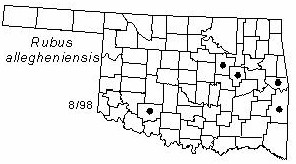Erect or upright shrub to 1 m (3 ft) in height. Twigs green to red-brown, young primocanes sparsely glandular; prickles with broad bases, straight, 3-5mm (0.1-0.2 in) long and scattered along the stem. Leaves alternate, palmately compound, 3-5-foliate; leaflets oblong to oblong-acuminate, 8-13 cm (3.3-5 in) long and half as wide; characteristically yellow-green in color, tomentose; subcordate at base; caudate at apex, margins serrate; petiole and rachis are spiny, pubescent, and glandular. Inflorescence a terminal raceme with 12-many flowers, lowest flowers are subtended by a leaf, pedicels glandular; calyx 5-lobed, acute, pubescent and glandular; petals 5, white, narrow; pistils many, inserted on hypanthium; stamens numerous; flowers appear from May to July. Fruit an aggregation of drupelets, about 2 cm (0.8 in) long, oblong, deep-violet; nutlets numerous, yellowish, reticulate; fruits mature in July.
Distribution: Oklahoma, Arkansas, Missouri, east to North Carolina, north to Nova Scotia and Quebec.
Habitat: dry prairies, woodland margins, roadsides and stream margins.
Comment: Rubus is a Roman name meaning red; allegheniensis named for the Allegheny region.
Field identification: Highbush blackberry is often confused with R. ostryifolia and R. pensilvanicus. Highbush blackberry has abundant red stipitate glands. Rubus is a complex genus. Species are difficult to identify due to frequent hybridization and introgression.
Food uses: fruits are eaten raw or used in jams, jellies, and sauces.
Wildlife benefits: blackberry fruits are eaten by many species of birds and mammals.
NWI status: UPL,FACW.
Distribution in Oklahoma: 
BACK
NEXT
RETURN TO INDEX
Last update: 9/17/99
 Go to Oklahoma Biological Survey Home Page
Go to Oklahoma Biological Survey Home Page
 Disclaimer
Disclaimer